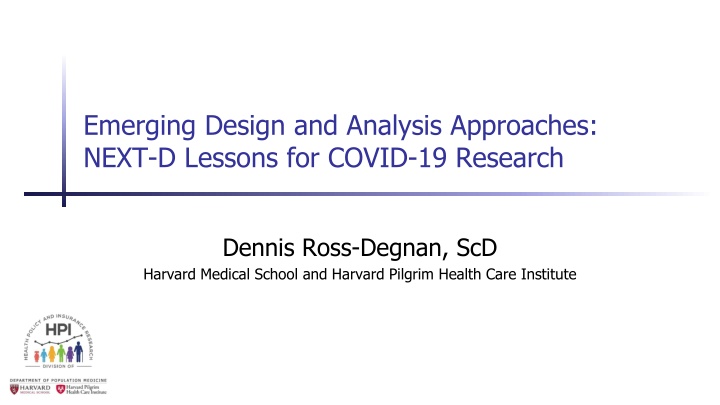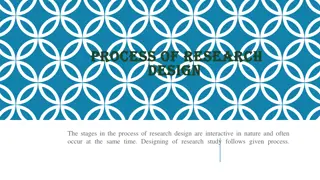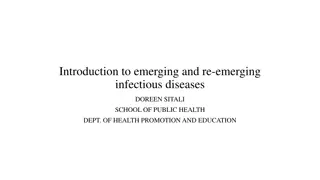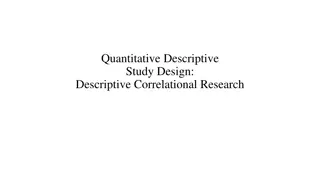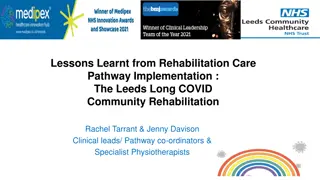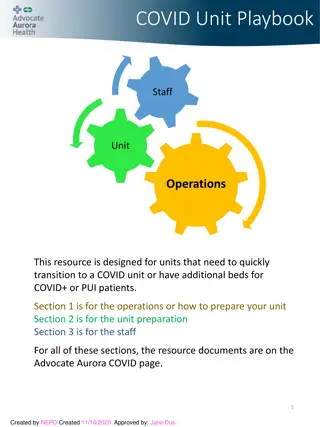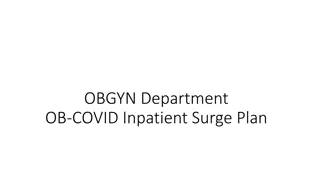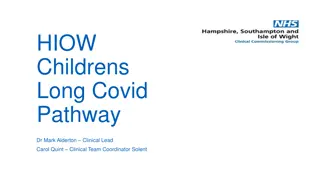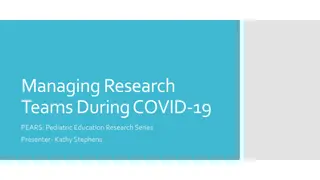Emerging Design and Analysis Approaches in COVID-19 Research
Dennis Ross-Degnan from Harvard Medical School discusses the NEXT-D lessons for COVID-19 research, focusing on study design, bias reduction, data metrics, and the value of long-term research consortia like NEXT-D. The content covers interventions, comparators, observational study design issues, and analysis approaches such as difference in difference and regression discontinuity.
Download Presentation

Please find below an Image/Link to download the presentation.
The content on the website is provided AS IS for your information and personal use only. It may not be sold, licensed, or shared on other websites without obtaining consent from the author.If you encounter any issues during the download, it is possible that the publisher has removed the file from their server.
You are allowed to download the files provided on this website for personal or commercial use, subject to the condition that they are used lawfully. All files are the property of their respective owners.
The content on the website is provided AS IS for your information and personal use only. It may not be sold, licensed, or shared on other websites without obtaining consent from the author.
E N D
Presentation Transcript
Emerging Design and Analysis Approaches: NEXT-D Lessons for COVID-19 Research Dennis Ross-Degnan, ScD Harvard Medical School and Harvard Pilgrim Health Care Institute
Overview NEXT-D2 interventions and COVID-19 research Study design and approaches Bias reduction and balancing Attention to denominators Measurement and metrics Data linkages Value of long-term research consortia like NEXT-D NEXT-D COVID-19 Enhancement Grants 2
NEXT-D2 Interventions, Comparators, and Relevance to COVID-19 Research Practice-level and system-level differences Medicare coverage expansion: Practices/systems that bill service vs. not (Penn State, Tulane) Medicaid expansion: High vs. low performing CHCs (OHSU) Adoption of HIT and care management (Berkeley) Insurance coverage Medicaid Care Coordination Organizations: Qualifying acceptors vs. non-acceptors (UCLA) Medicaid Health Homes: Outreached/enrolled vs. outreached/not enrolled vs. not outreached (Mt Sinai) Medicare coverage expansion: Exposed vs. not (Tulane, Penn St) Employer adoption of reduced cost sharing: full replacement vs. not (Harvard) State-level policy differences Medicaid expansion vs. not (OHSU, N western) Receiving innovation funds vs. not (Berkeley) Determinants of practice and system differences in patient care and outcomes Effects of COVID-related policies (e.g., furloughs) or programs (e.g., patient outreach) Differential impacts of prior coverage policies on COVID utilization and outcomes Effects of reimbursement policies (e.g., coverage of telephonic visits) Impact of job loss on coverage and outcomes Differential impact of COVID within risk groupsor insurance groups Effects of state policies (e.g., shelter in place) or community differences (e.g., masking) 3
Design Issues in Observational Studies Baseline comparability of comparison groups Differential likelihood of receiving intervention Imbalance on observable factors Non-parallel trends in covariates or outcomes Post-intervention differences due to selection Differential regression to the mean Divergent trends due to unrelated interventions Post-intervention changes in population Insurance or program churning Health system entries or exits 4
Study Design and Analysis Approaches Difference in difference With stratification With matching/weighting Dynamic effects Interrupted time series Survival/segmented survival Regression discontinuity 5
Bias Reduction and Balancing Group- and individual-level selection Employer interventions (Harvard) State interventions (Berkeley, N western) Balancing comparison groups Longitudinal matching and trajectory balancing (Harvard, Mt Sinai, Tulane, Penn St) Combining coarsened exact & propensity matching (Harvard) Comparing multiple balancing weights (Mt. Sinai, N western) Resources: Thomas et al. Matching with time dependent treatments: A review and look forward. Statistics in Medicine 2020 6
Attention to Denominators: Importance for NEXT-D and for COVID-19 Research on Diabetes Care Defining exposed population Timing of exposure Selection bias Key analysis issues Differential uptake and impacts Continuity in system Out-of-system care Analysis approaches Doubly robust estimation Multiple analysis methods Dose response / implementation depth Heterogeneous treatment effects 7
NEXT-D2 Measurement and Metrics Issues Relevant to COVID-19 Research ICD-9/10 discontinuities (Harvard, Penn St) Measure of acute diabetes complications (Harvard) Continuity and coordination of care (Mt. Sinai, OHSU, Tulane, N western, Harvard) Race/ethnicity/income/social determinants (all groups) Modeling dynamic effects (N western, UCLA, Berkeley, Harvard, Mt Sinai) Telemedicine impacts (Penn St, Mt. Sinai, Tulane) Sun & Abraham. Estimating Dynamic Treatment Effects in Event Studies with Heterogeneous Treatment Effects. 2020 8
Value of Long-term Diabetes Research Consortia like NEXT-D in the Era of COVID-19 Flexibility to pivot Changes in natural experiment interventions New study questions (e.g., COVID-19 impacts) Changes in data availability Shorten time needed for data assembly, linking, validation Strengthen and extend efforts at data coordination and integration (e.g., PaTH Network, REACHnet,) Interdisciplinary perspectives (clinicians, epidemiologists, economists, methodologists, social scientists) Input on questions and methods Ongoing stakeholder engagement in research process 9
Summary Collaborative work on study design, balancing, and analysis methods has strengthened NEXT-D studies of diabetes-related natural experiments Many methodological lessons from NEXT-D translate directly into strengthening the design and analysis of research on the impacts of COVID-19 Risk factors for COVID-19 and clinical impacts Effects of health system disruptions due to COVID-19 and of health system adaptations to address these disruptions 10
Thank you! 11
